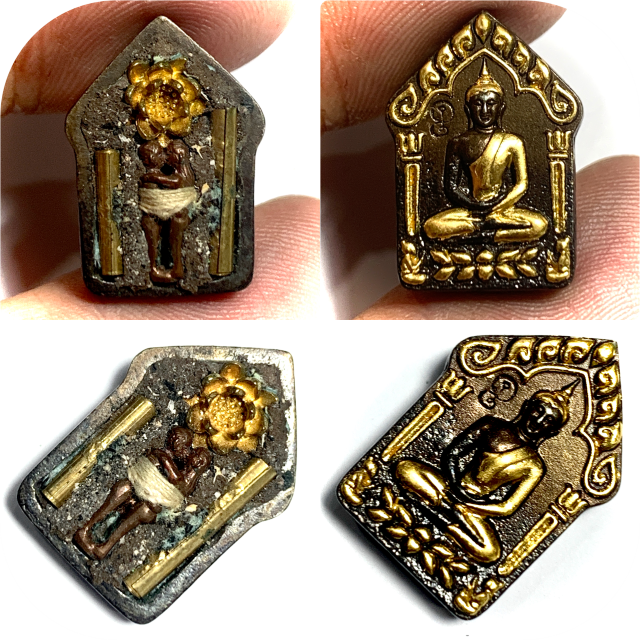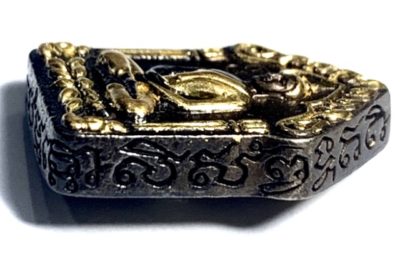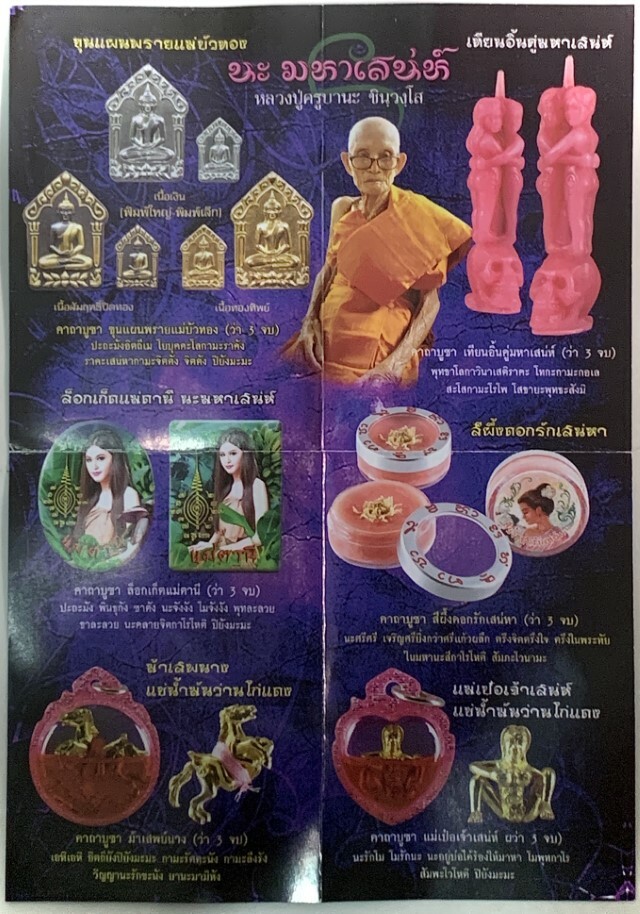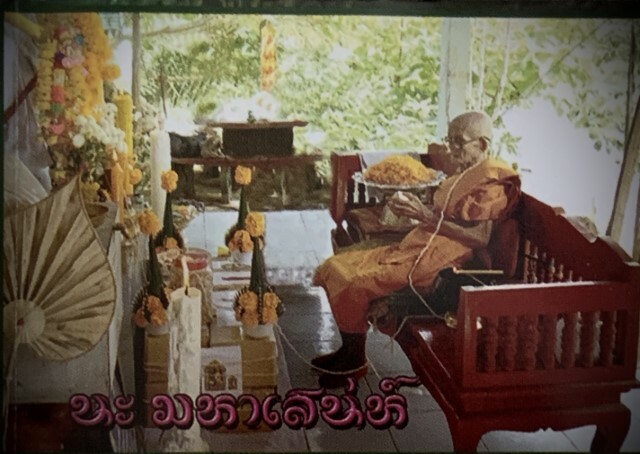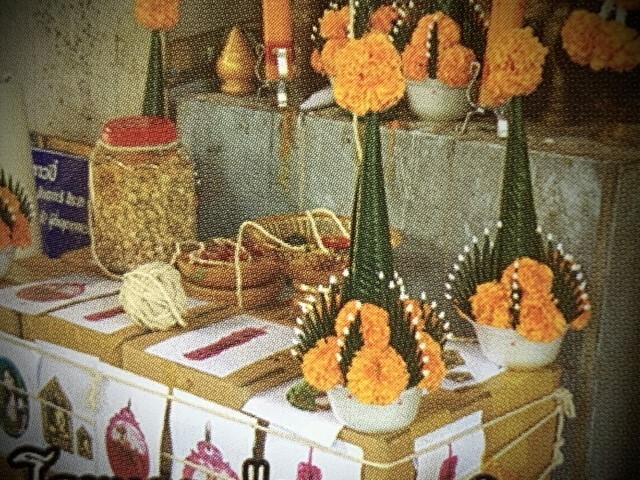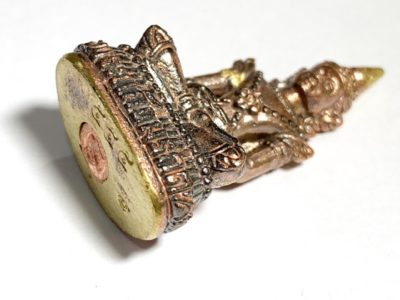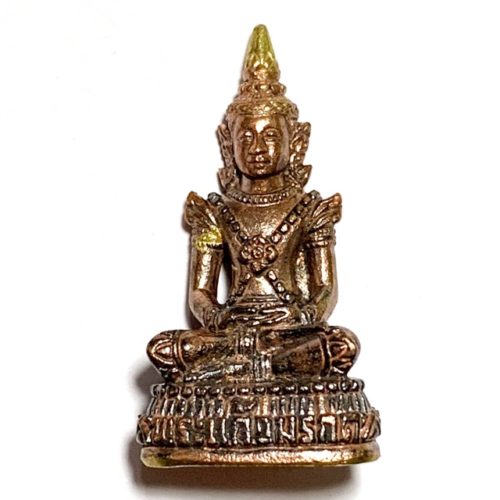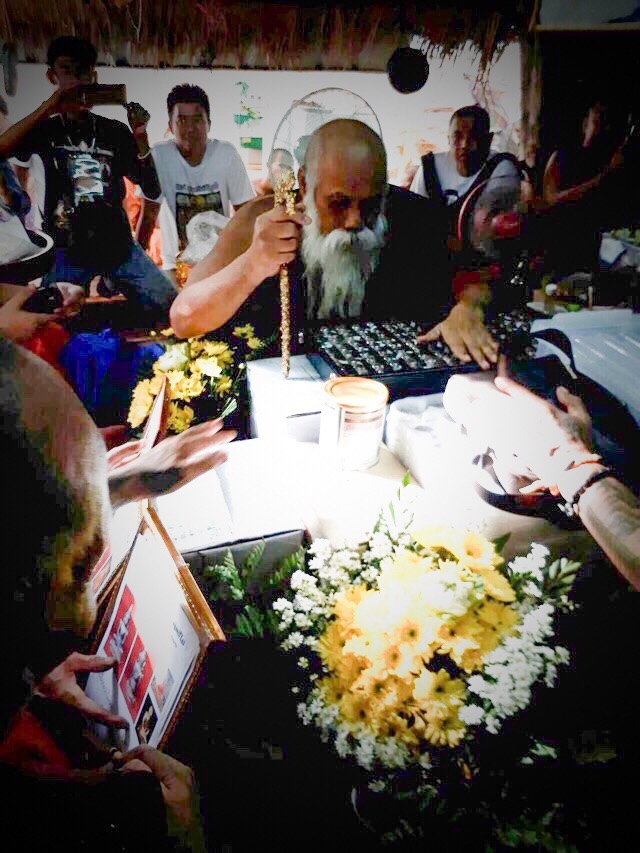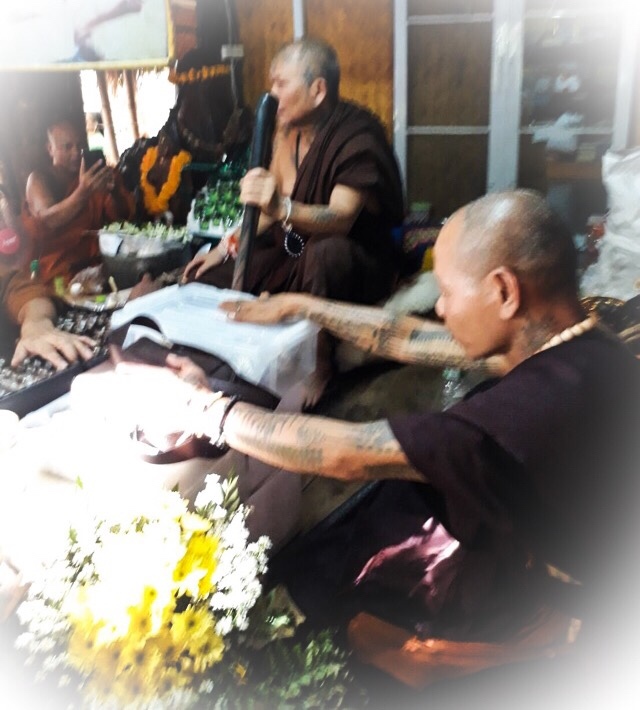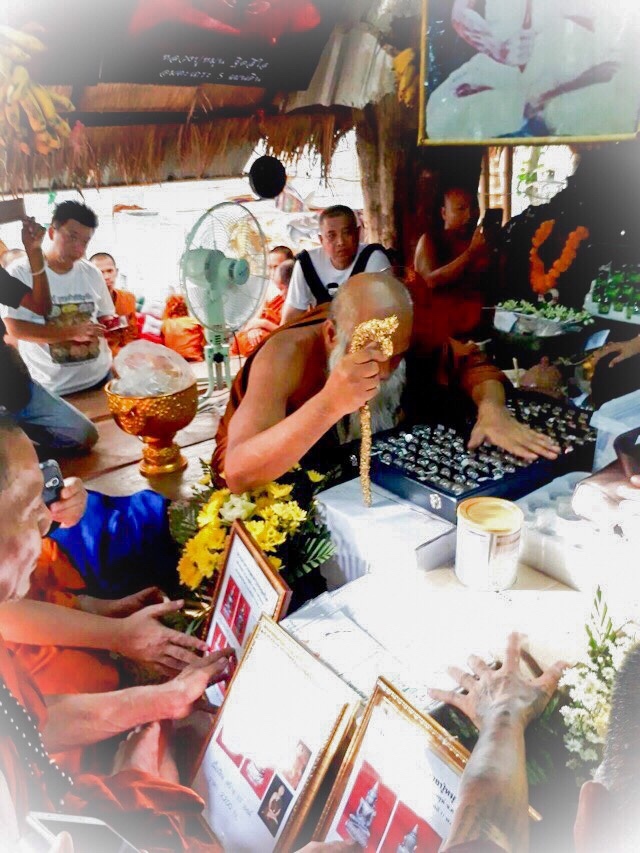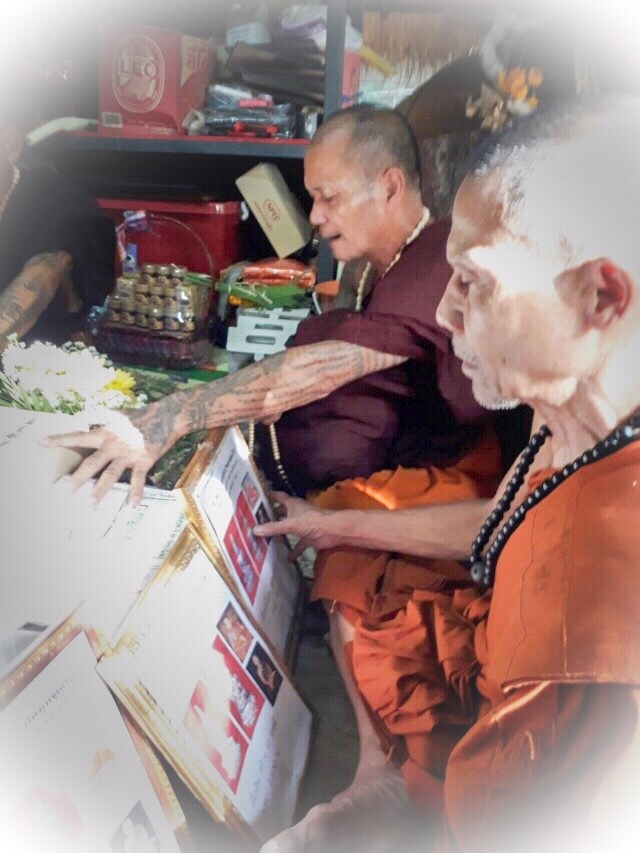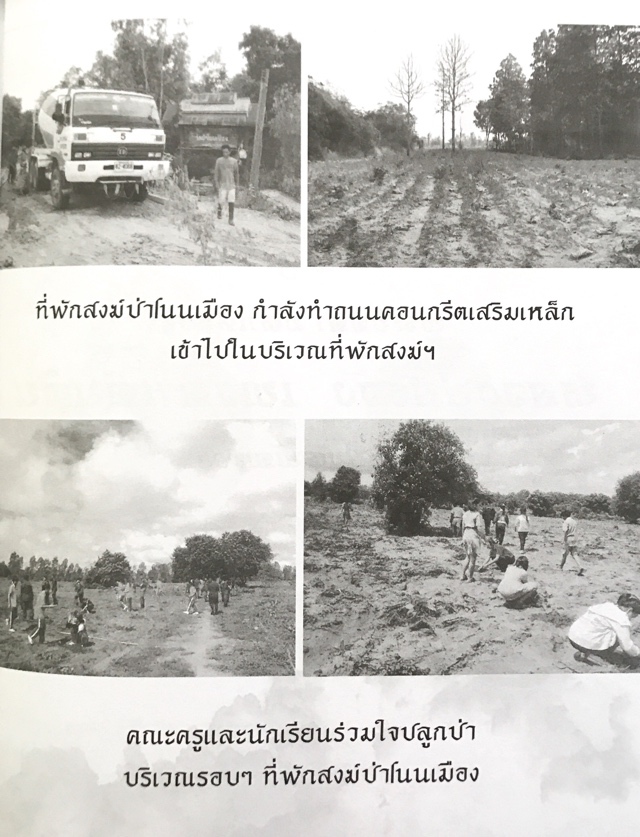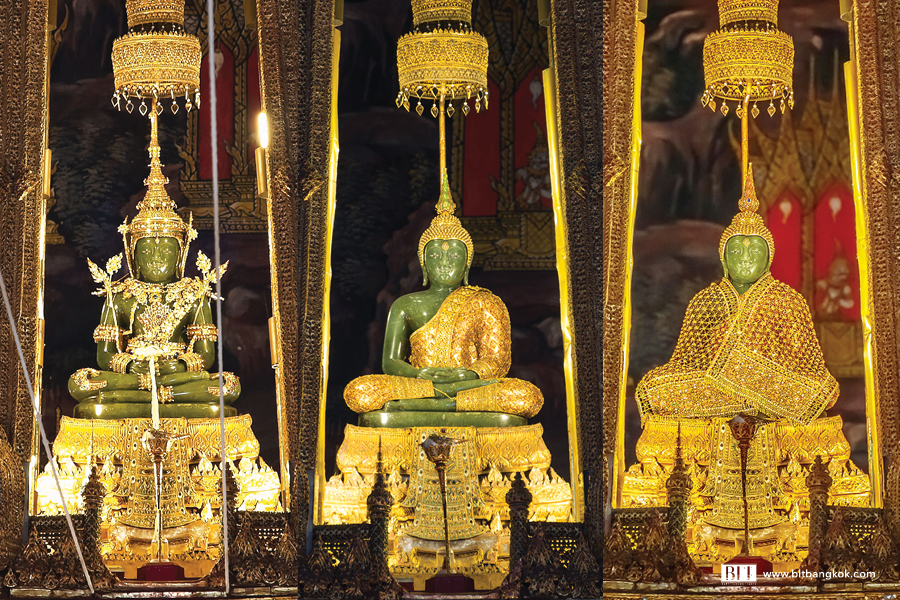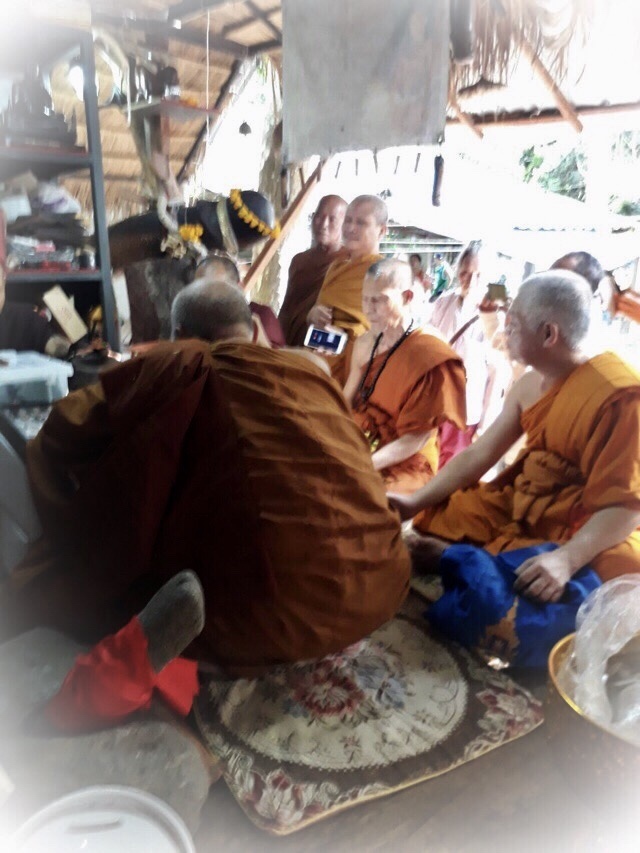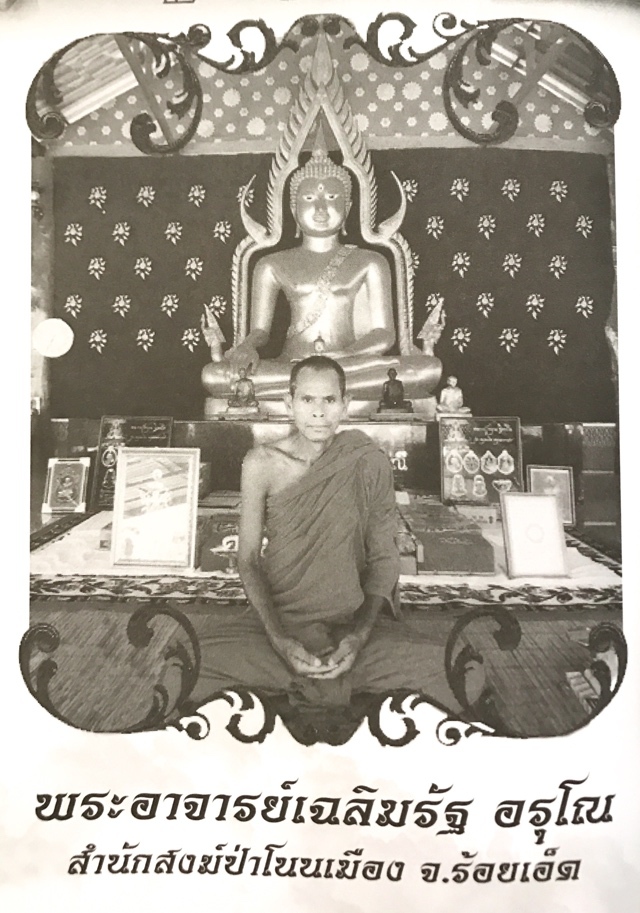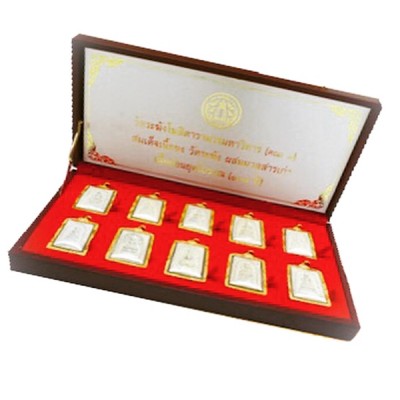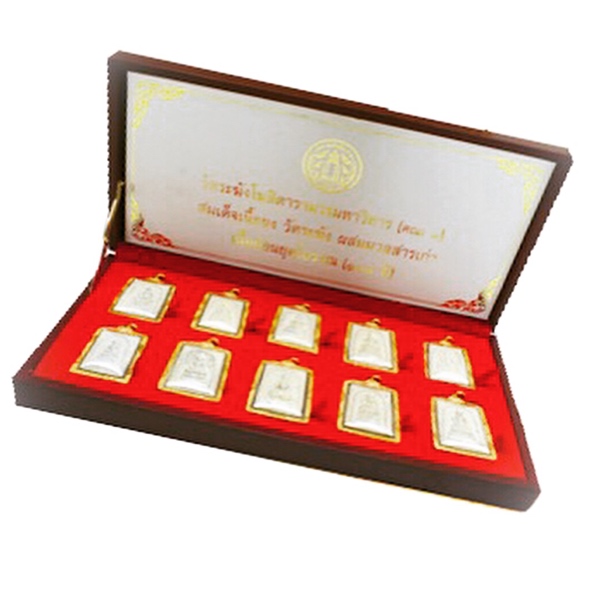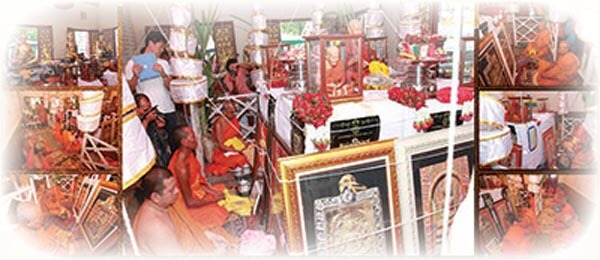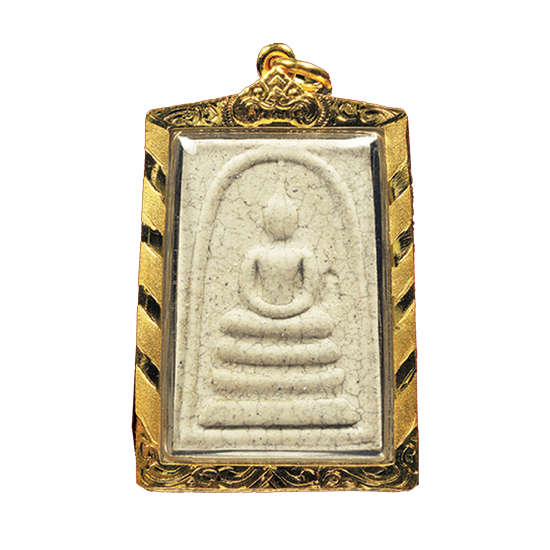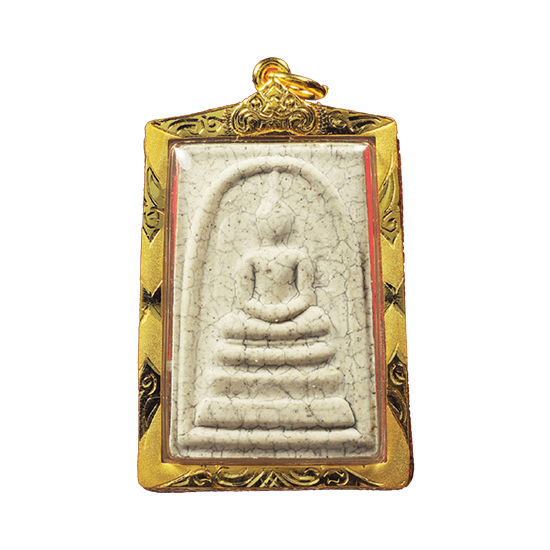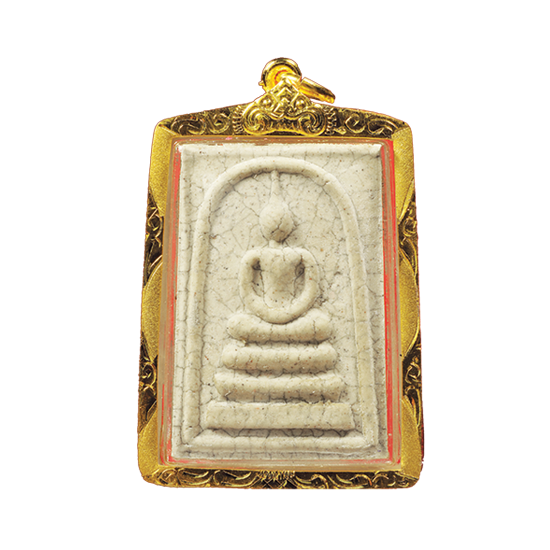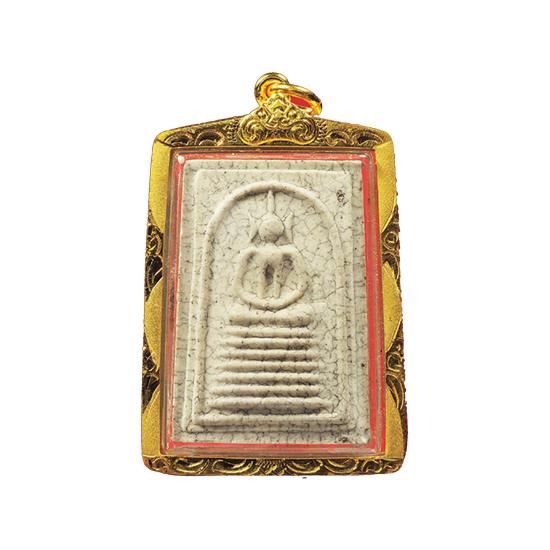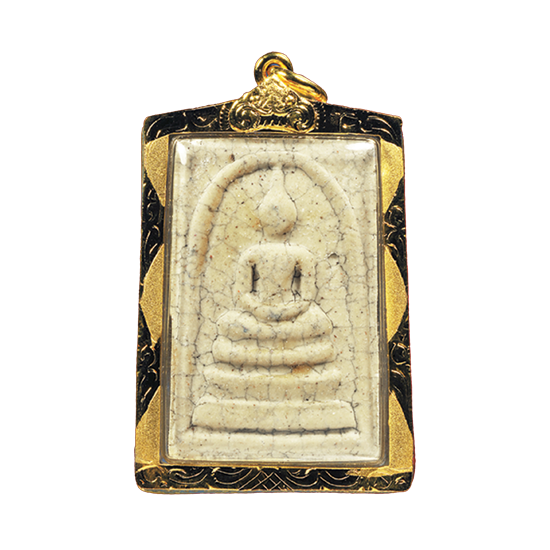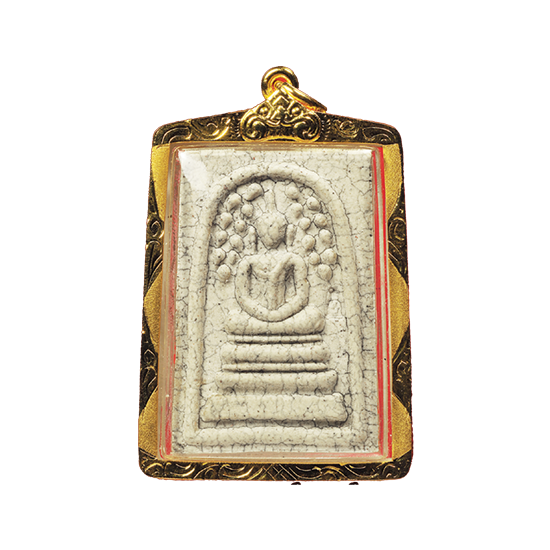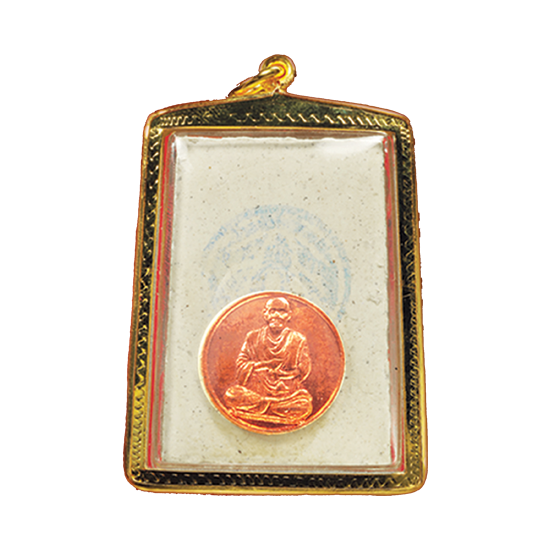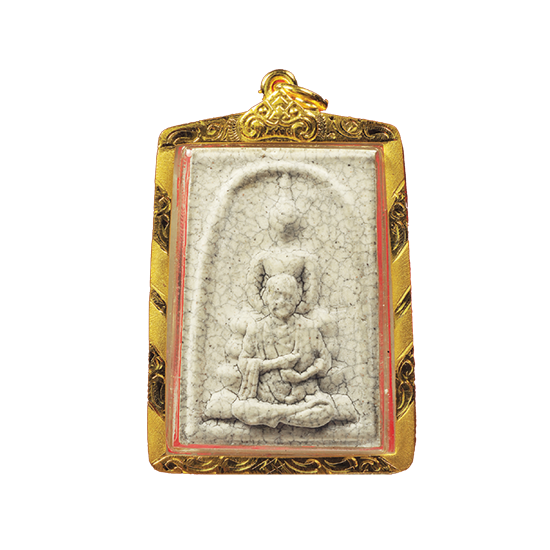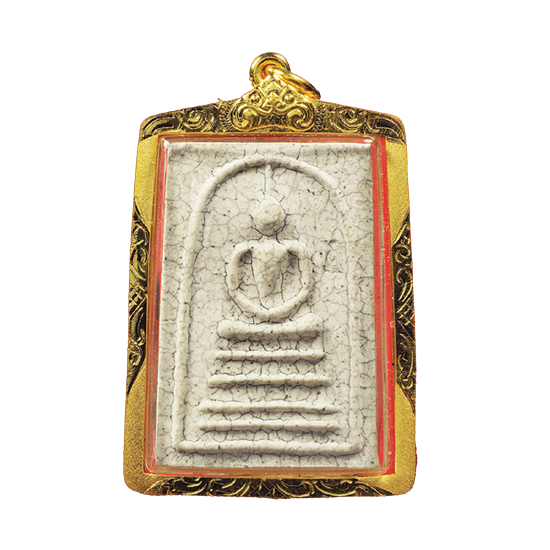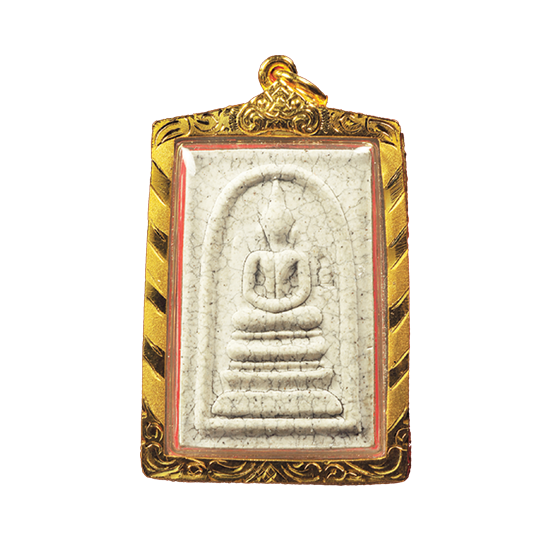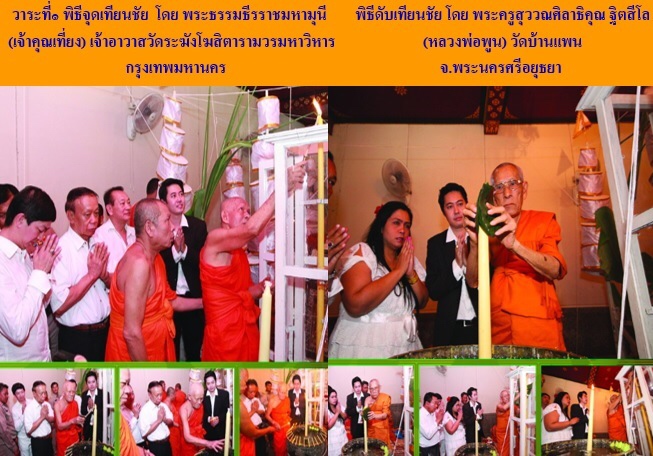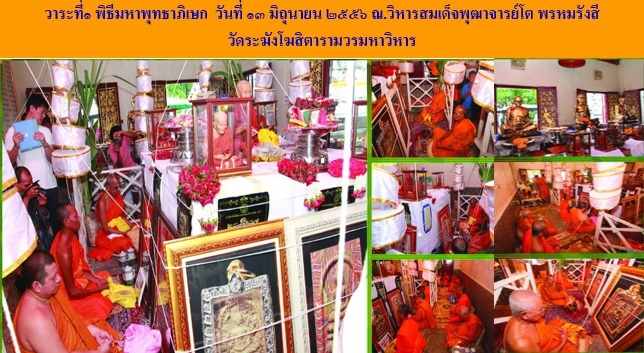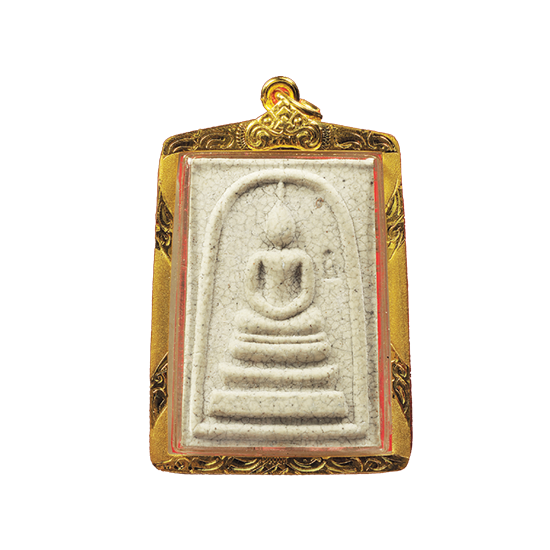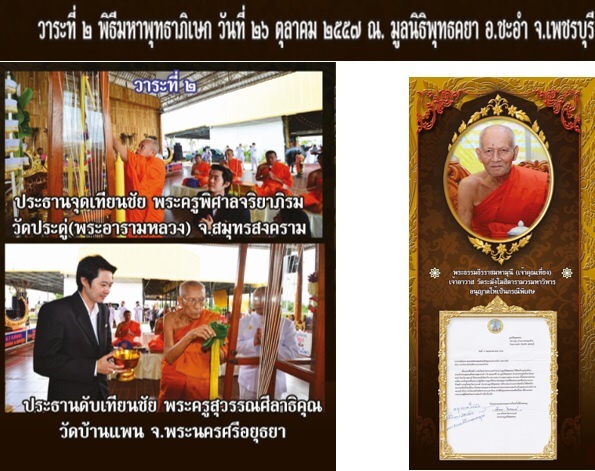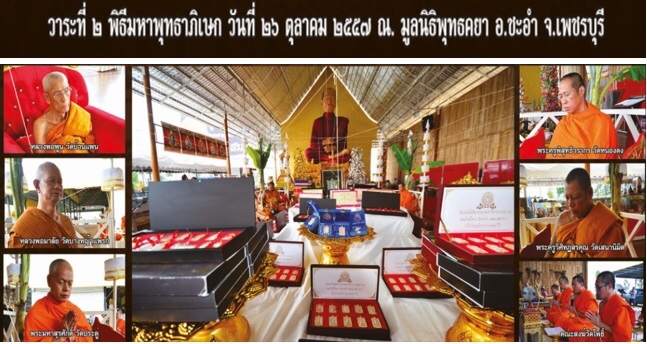Ongk Kroo Pim B Version of the Pra Khun Phaen Na Sethee Hnaa Loha Chup Ongk Tong Black Sacred Metal front face with Golden Buddha, filled with Sacred Powders, Dork Rak Sorn and Sinjana Cord Bound In Koo statuette in Rear. Released in the First and Final ‘Run Raek Lae Run Sud Taay’ Edition, from Luang Phu Kroo Ba Na Chinawangso, of Samnak Songk Doi Ihuy, from 2559 BE.
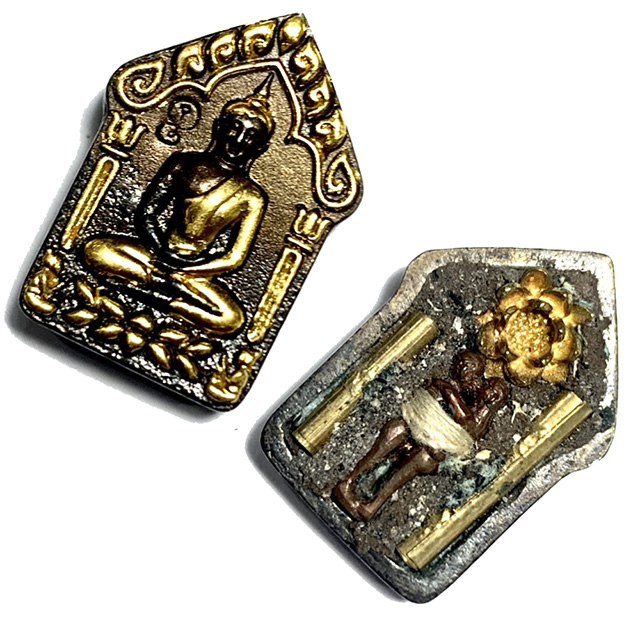
This model (Pim) is a {im Lek small version of the Ongk Kroo Pim B special Gammagarn model, and has the Na Hua Jai Khun Phaen, and Khom Agkhara spells embedded into the front and edges of the Blackened Sacred Metal Face, with Golden Buddha Image, & a Code Na Hua Jai Khun Phaen stamp on front face, with Sacred Khom Agkhara spells around the rim. The rear face is filled with Maha Wan Powders, and Earthen Muan Sarn Clay, Sacred Minerals, with 2 Takrut, a brass Dork Rak Sorn Flower of Love and Enchantment, inserted, along with an In Koo Loi Ongk Statuette, for Metta Maha Sanaeh.
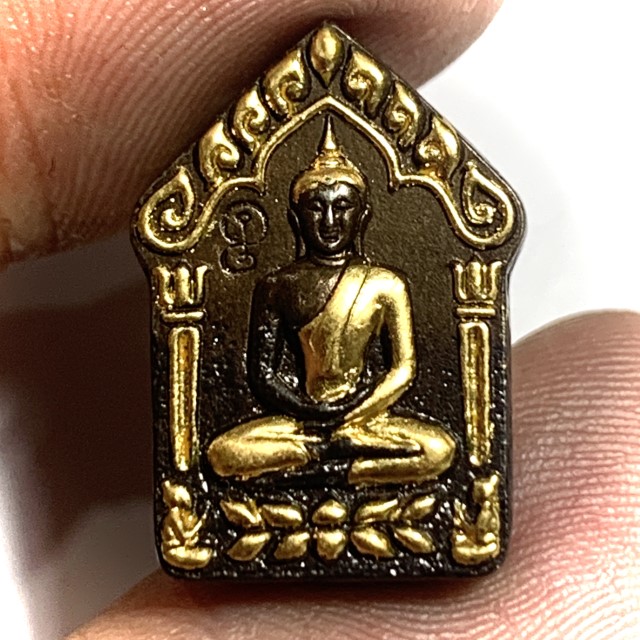
This first and final series was made shortly before the passing of the great Luang Phu Kroo Ba Na, and is the last edition ever empowered by Luang Phu Na Chinawangso, of Samnak Songk Doi Ihuy, before his passing.
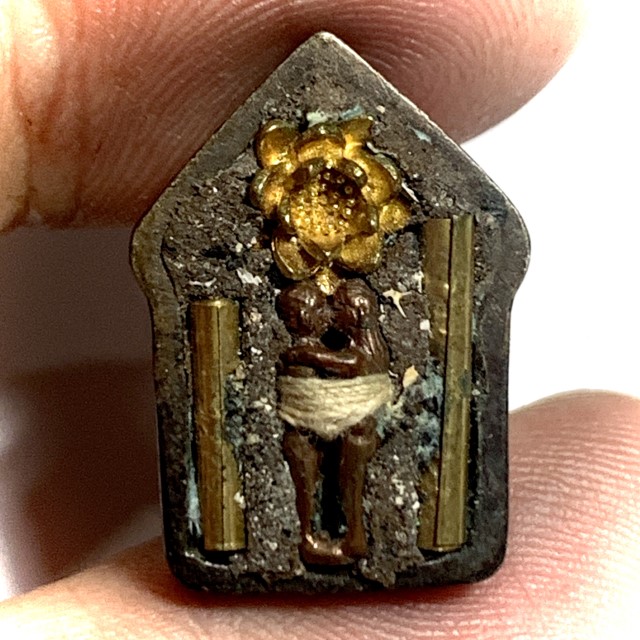
The edition included candles made in the images of In Koo, as well as some See Hoo Ha Ta five eyes four ears Money Deity.

Above & Below;
Sacred Khom Khmer Sanskrit Magical Agkhara Script Spells are inscribed along the edges of the metallic foil cover of the front face of the Khun Phaen amulet.
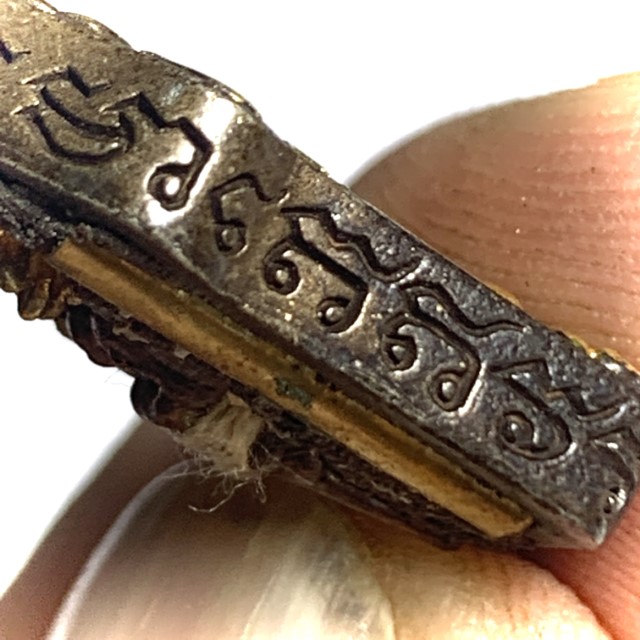
In addition, some lockets with the Nang Prai Mae Thanii Banana Tree Lady Ghost, See Pheung Dork rak Sanaeha lip gloss attraction potion, In Ma Saep Nang Lady-Horse Lanna Sorcery Animist Charm, and the Khmer Necromantic Mae Bper Fertility and Prosperity Deity of Mercy, in Loi Ongk Statuette Form, as well as some Ling Kin Kluay Banana Eating Monkey statuettes, with Sacred Muan sarn fullled bases. The Ling Kin Kluay was issued as free standing statuette or encased within a decorative transparent conservatory (decorative Takrut casing).
Luang Phu Na Chinawangso has made this amulet using a very old Wicha for Maha Pokasap, Metta, Maha Lap Magic, which is also imbued with Serm Duang and Maha Lap, for Good Karma, and Lucky Fortunes.
The rear face of the amulet, has three Takrut with a strip of Jivara Monk’s Robe attached for Buddhist Blessings, with the three Kings (Sam Kasat) Takrut bringing Metta Mahaniyom Mercy Charm, and Serm Duang Karma Improvement, as well as Maha Lap Lucky Fortunes.The Paya Gai Gaew brings Pokasap Wealthy Fortunes and Treasured POssetions, and Ease of Survival, as well as Power over Others. The In Koo Brings Maha Sanaeh, Metta and Kaa Khaay to increase Business and Popularity in the Profession and Social Scene, and to Bind the Hearts of your Lover’s
Kata Bucha for Wealth
Chant Kata Maha Namasakara 3 Times;
Namō Dtassa Pakawadtō Arahadtō Sammā Samputtassa
Namō Dtassa Pakawadtō Arahadtō Sammā Samputtassa
Namō Dtassa Pakawadtō Arahadtō Sammā Samputtassa
Then Chant (3 Times);
NA MAA MEE MAA NGERN KAM MAA TONG KAM MAA NA CHAA LI DTI NA MA PA TA NA MOE PUT TAA YA
Then Chant (3 Times);
Ēhi Ēhi Mahā Lāpā Ēhi Ēhi Mahā Pōka Pawandtumē Ngern Kam Mā Tong Kam Mā Nachā Lidti
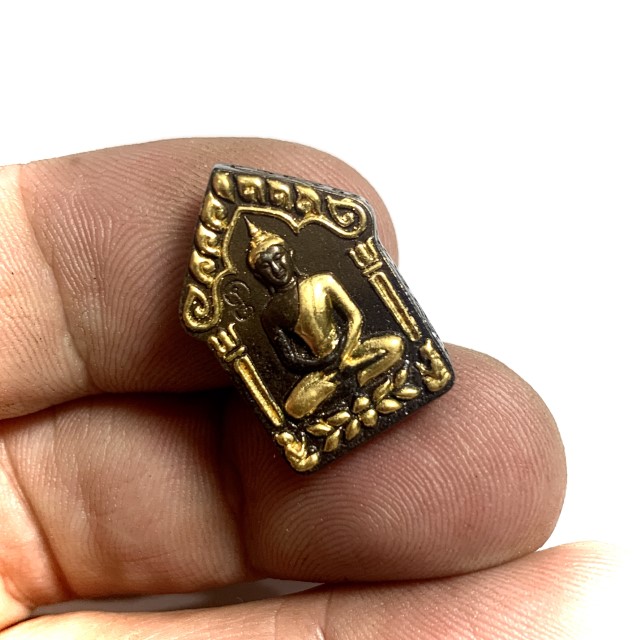
Released in 2559 BE, and Blessed by Luang Phu Na, under Auspicious Astrological Alignments in the Year of the Monkey. This was Luang Phu Na’s first and final ever edition of the Khun Phaen Na Sethee Series, making these a one off series of immense Sacred Value and collectability. His amulets have become immensely rare and in high demand since his passing away.

Luang Phu Na Chinawangso was a Looksit of Kroo Ba Srivichai, and is the inheritor of the Master Lineage Sorcery of Kroo Ba Apichai Khaw.
This final edition was released in 2561 BE, and Blessed by Luang Phu Na,
under Auspicious Astrological Alignments for that year, after which Kroo Ba Na passed away, which is strange as his edition was deliberately named ‘Na Sethee Run Raek Lae Run Sud Taay’ (first and last edition), as if he knew that this would be his last. The Pra Khun Phaen amulet is famous for its Protective Magic, Wealth Accumulating, and mercy Charm as well as its immense power of seductive attraction, and has been revered for well over 200 years since the Ayuttaya period, and especially since the burial find of the Khun Phaen Wat Ban Krang in Supanburi.
The rise of the popularity and fame of the Khun Phaen amulet and legends, also caused the massive increase in public popularity, of the Wicha Kumarn Tong, for which Khun Phaen is credited with the revelation of the Wicha, which he received from pra Ajarn Kong, his Kroo Ba Ajarn at Wat Kae.
The Invocation Summoning, Awakening and Turning of the Four Elements was performed. to Reanimate Living Magic within the Static Form of the In Koo, according to the Ancient Grimoires and Magical Formulas of the
Wicha. Luang Phu Na Chinawangso has made the In Koo amulet inserted in the rear face, using the Wicha In Koo Plord Rak Maha Sanaeh, which is one of the most popular Wicha for Love Charms.
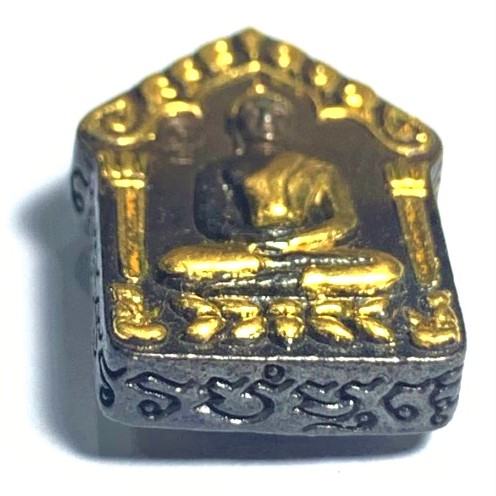
Useful for those who wish to strengthen existing Love Affairs, or get their Lovers, Husbands and Wives to return to the nest. The Wicha In Koo is a very old Wicha for Maha Sanaeh, Metta Mahaniyom, Kaa Khaay, Maha Pokasap
and Maha Lap Magic, which is as popular today as it was in ancient times with the Lanna Folk, and indeed around the world with Devotees of Maha Sanaeh magic.
The In Koo is an Animist Charm that was used in Olden
days by the Lanna Folk of the Northern Mountanous Regions, as a love binding spell, and for good commerce. The In Koo (also known in South East Asia as ‘Yin Tong’), is a symbiotic Deity, in the form of a Man and a Woman embracing each other.
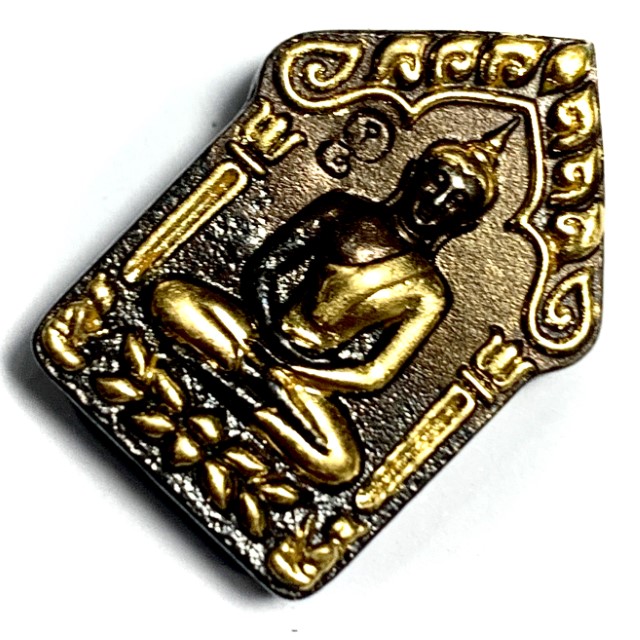
In Koo, is a magical animist effigy which ancient people believed represents the first ever pair of Man and Woman (male and female) in the History of the World, and is a symbol of Love between 2 persons. It is believed that the holder of an In Koo Talisman is endowed with Maha Sanaeh power over the other sex, and that they will feel attracted to the wearer of the In Koo, and wish to approach and get to know you.
If they approach, then they will be helpless against the attraction power of the Palad In Koo. This is the Love Charm Magic of Maha Sanaeh (Charm and Attraction). If the In Koo is kept in the House, then all the family and people in the household will love each other and be happy together.
If it is worn as a love charm or carried on ones person, then it will cause everyone the wearer meets to feel friendly and compassionate towards them, and even make others fall in love with the wearer if Bucha is made to the In Koo, and this request is asked for in exchange for
Bucha. Business will flourish, money and gifts will flow in, good fortune will come, and life without disturbances.
The In Koo is a sacred Love and Metta Maha Sanaeh Talisman which has been used by ancient folk for thousands of years, and shows no sign of disappearing soon, for its popularity as a love charm is still as
evident as it ever was. For Choke Lap wealth increase, place the In Koo inside a money bowl or savings box. Before you put or remove any money from the box, you must tap or knock on the side of the container with
the same hand you shall be using to remove or place money in the box with.
Kata In Koo
Chant
the Kata 7 times before putting your hand inside the container. It is
said that if you do this regularly, that money will never cease to flow.
Those who perform this well will find time to sit and meditate and
chant the Kata whilst tapping on the container. About 5 minutes each
time is enough.
Kata In Koo Perm Sap (Increase Wealth)
Om Raachaa Taewaa Swaahome Om Taewee Maama Jidt-Dtang Arahang Swaahome
Kata for making the In Koo perform as ‘Sanaeh’ (attraction charm) against the opposite sex;
Ung BpiyaBpiyang Sinohang Bpa Jidt-Dtang Bpiyang Ma Ma.
Then, in the case that a man is to be enchanted, chant;
In Gaew Maa Lo Bpuriso Bpiyang Ma Ma Mang So Sang Yo Ko Mang Mang (chant 4 times)
Or, in the case that a woman is to be enchanted, chant;
In Gaew Maa Lo Idthii Bpiyang Ma Ma Mang So Sang Yo Ko Mang Mang (chant 4 times)
Kata for calling the In Gaew/Yin Tong to assist in selling your wares, and attract customers;
Om In Gaew Naree Jag Chuay Khong Gaa Duay Bpaag Khunanaang Han Khong Loo Gan Sir Hyub Laew Ruad Lerm Waang Om Swaahum Dtid.
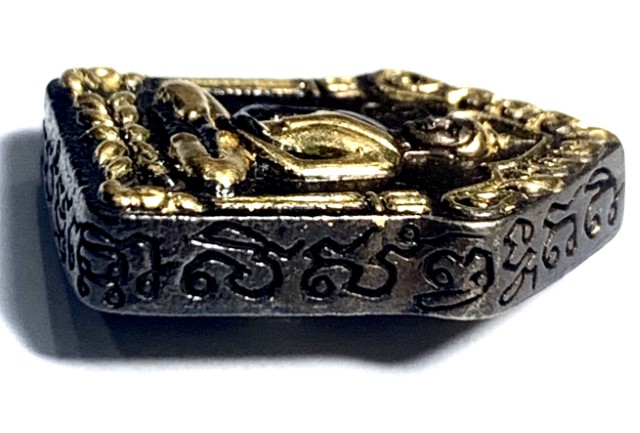
Kata Pra Khun Phaen
Kata Rak Sorn Love and Entourage Attraction Spell
